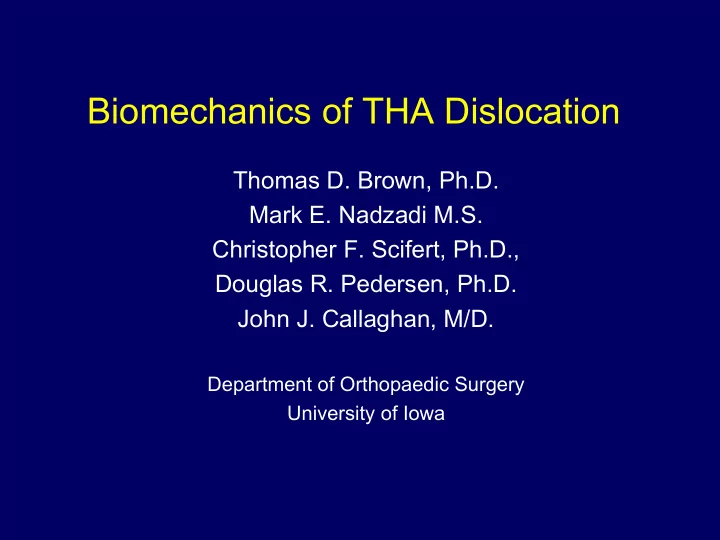

Biomechanics of THA Dislocation Thomas D. Brown, Ph.D. Mark E. Nadzadi M.S. Christopher F. Scifert, Ph.D., Douglas R. Pedersen, Ph.D. John J. Callaghan, M/D. Department of Orthopaedic Surgery University of Iowa
Rationale for Study •250,000 THA’s per year •2 nd leading cause of failure •2 - 11% primary cases •4 - 25% revision cases •$75M per year (Morrey, 2000) •Pain, Incapacitation
Clinical Studies •Registries •Limited statistical power •Conflicting conclusions •Malposition of cup •Empirical “safe-zone” •30-50° Tilt & 5-25° AV (Lewinnek et al., 1978) •Factorial associations, but not actual mechanisms
Experimental •Cadaveric studies •Limited observation variables •Small sample size (statistical power) •Mainly ROM studies •Need to examine local deformation and characterize dislocation mechanics
Computational •n=1 •Efficient parametric studies •Design •Orientation •Motion Challenge •Local deformation & stress •Many outcome measures (ROM, resistance) •Historically simplified (model, formulation)
Acetabular Cup: •Duraloc 22 - 52mm •Ti shell •UHMWPE liner Femoral Component: •Endurance stem •22mm modular head •CoCr Alloy DePuy, Inc.
Software • PATRAN 8.5 - IGES • ABAQUS 5.8 •Acetabular Cup • Bonded between UHMWPE liner & Ti shell • 3920 brick elements •Femoral Component • E CoCr >> E liner • Rigid Bezier surface
Physical Validation 1.8 1.6 Experiment Experim ental Data Resisting Moment (N-m) 1.4 FEA Finite Elem ent Results 1.2 1 0.8 0.6 0.4 0.2 0 55 56 57 58 59 60 61 62 63 64 65 66 67 68 69 70 71 72 A ngle (deg)
Kinematic and Kinetic Input •10 healthy subjects (5 male / 5 female) •Age (yrs): 49.7 ± 4.97 (44 - 59) •Height (m): 1.71 ± 0.14 (1.50 - 1.96) •Mass (kg): 77.3 ± 23.8 (40.9 - 122.7) •Optotrak •Pelvic reference frame •Recessed force plate
7 Maneuvers Tracked SSN / SSL XLG TIE 46 / 39 cm
STOOP PIVOT ROLL
Kinematic Data 8 90 •Cardan angles 7 Flexion 80 6 70 Physiologic Load (BW) - Flexion Cardan Angles (Deg) 60 5 50 4 - Adduction Joint Load 40 3 30 - Endorotation 2 20 Adduction 1 10 Endorotation 0 0 0 10 20 30 40 50 60 70 Kinetic Data Frame Number •47-muscle inverse dynamics model •Temporally varying load vector
Peak Resisting Moment 9 8 Subluxation 7 Resisting Moment (Nm) Regime Hooking 6 5 4 3 2 Dislocation 1 Impingement 0 85 90 95 100 105 110 115 120 125 Flexion Angle (deg)
UHMWPE Stresses Impingement VMES (MPa) Von Mises (MPa) Site 0.02 1.52 3.02 4.51 6.01 7.51 9.01 10.5 12.0 13.5 Egress 15.0 Site 33.6 Stable Incipient Articulation Dislocation
Influence Factors Femoral Component Anteversion Head Size Head/Neck Ratio Metal Backing d θ b Polyethylene Liner Leg Cross, Rise-from-Seat, Pivot, Bed-Rollover Stooping, Shoe-Tying
Femoral Anteversion Effect 12 Average 0.4 ° more flexion per degree of femoral anteversion 10 Resisting Moment (N-m) 8 6 4 0 Anteversion 10 Anteversion 15 Anteversion 2 20 Anteversion 0 90 95 100 105 110 115 120 125 130 135 Flexion Angle (deg)
Anteversion Effect 50° Tilt 12 40 30 Resisting Moment (Nm) 20 10 10 8 0º 6 4 2 0 75 85 95 105 115 125 135 145 Flexion Angle (deg)
Tilt Effect 20° Anteversion 12 70 60 Resisting Moment (Nm) 50 10 40 8 30º 6 4 2 0 75 85 95 105 115 125 135 145 Flexion Angle (deg)
Dislocation Resistance Improvement Moment R.O.M. Erectly Seated Leg Crossing
22 mm Head Size Variation 26 mm (Constant H/N Ratio) 28 mm 32 mm Impingement Head/Neck Ratio Variation 90 97 104 111 118 125 132 Flexion Angle (deg) (Constant Head Size) 14 H/N = 1.89 Resisting Moment (N-m) H/N = 2.39 12 H/N = 2.89 10 8 6 Impingement 4 2 0 90 97 104 111 118 125 132 Flexion Angle (deg)
Moment Change in Resisting Moment (%) Range of Motion Change in R.O.M. (degrees) 15 6 10 4 5 2 0 0 -5 -2 -10 -4 - 15 -6 - 20 -8 Backing 15 25 35 45 55 Liner Chamfer Angle θ (degrees) d Design Trade-Offs θ b Polyethylene
Finite Element Results # of % of Trials Maneuver # of Trials Dislocations Dislocating Low 47 41 87 Sit-to-Stand Normal 55 33 64 Sit-to-Stand Tie 69 31 45 Leg 64 22 34 Cross Stoop 42 6 14 Post. Disloc. 277 133 48 Maneuvers Pivot 58 23 40 Roll 19 12 63 Ant. Disloc. 77 35 45 Maneuvers Overall Series 353 168 47
Summary (Placement) • Femoral Anteversion – ↑ ROM but not resistance • Acetabular Tilt & Anteversion – ↑ ROM and Resistance …. Posterior Dislocations
Summary (Design) • Head Size ↑ Resistance • H/N ↑ ROM • Acetabular: ROM / Resistance Trade-off – Inset, Chamfer Angle, Lip Width
Summary (Patient Motions) • Posterior vs. Anterior Dislocations – Similar average risk (48-45%) – Posterior maneuvers more frequent? • Wide variability of risk: 14 - 87% • Highest risk: – Rising from low seat (87%)
Acknowledgements Financial Support DePuy, Inc. VA Merit Award Assistance Mr. Jason Wilken Ms. Ruchika Wahi Mr. Mike Squire Ms. Hannah Lundberg
Recommend
More recommend